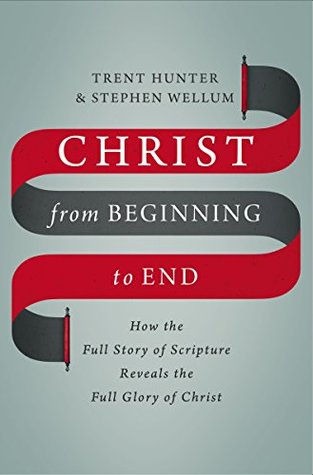More on this book
Kindle Notes & Highlights
by
Trent Hunter
Read between
January 28, 2020 - December 28, 2021
In part 1, they give us the tools to use, such as covenants and types. In part 2—most of the book—they walk us through the story of the Bible in eleven episodes.
I already know of one way I hope to use this book: helping me to think about how to lead the congregation that I serve in prayers of praise as we focus on this theme or that in the character of God.
the disciples had all the pieces of the Old Testament in front of them, but until Jesus put the pieces together properly, they failed to grasp that the Scriptures’ message centered in him.
Properly read, the story of the Bible makes plain the way of salvation: in Christ alone, by grace alone, and through faith alone.
Do not miss this: the Bible itself teaches that we must know the Bible’s story if we want to know Christ and defend this gospel.
First, Paul establishes the identity of God as Creator.
Second, Paul establishes that God is independent and self-sufficient.
Third, Paul explains that God reveals himself.
Fourth, Paul declares that humans have rebelled against God as their Lord.
Fifth, Paul then instructs the Athenians that all humans are to turn from their idolatry to the living God because a day of future judgment is coming:
Finally, only after constructing the Scriptures’ big picture does Paul proclaim Jesus as the man whom God raised from the dead to judge the world.
The big picture reveals a big Christ. Jesus is not one religious leader among many. Set within Scripture’s own framework and teaching, Jesus is presented as the exclusive Lord, Savior, and Judge of the world.
In the close context, we interpret the passage in front of us. In the continuing context, we read any biblical passage in light of what preceded it. Then in the complete or canonical context, we interpret the passage in light of the Bible’s entire storyline.
The close context.
The continuing context.
The complete or canonical context.
If we disagree with something the Bible teaches, we assume that our thinking must change, not God’s. We don’t stand over Scripture; we stand under it in submission to God
covenants are the backbone of Scripture’s grand story, holding its four-part skeleton together.
While a contract involves a relationship for the sake of obligations, a covenant involves obligations for the sake of a relationship. A covenant is a chosen relationship between two parties ordered according to specific promises.
in a covenant, the relationship is primary, and the promises made to each other serve the higher purpose of the relationship.
God’s Covenant with Creation through Adam and Noah
God’s Covenant with Abraham and His Children
God’s Covenant with Israel through Moses
God’s Covenant with David and His Sons
God’s New Covenant in Christ
God’s covenants are part of God’s one plan of salvation.
God’s covenants progress from one to another.
God’s covenants are unconditional and conditional.
Jesus Christ simultaneously meets God’s own righteous demand and acts as our obedient covenant representative and substitute.
God’s covenants are revelatory; they reveal who God is and his plan.
the Bible moves from promise to fulfillment in Christ through the biblical covenants.
The simple way to grasp this is to say that the Old Testament is the story of God’s promise and the New Testament is God’s fulfillment of all he has promised.
Since our triune God is the Lord of history and the single author of Scripture, through various types he prepares us for the fulfillment of his plan centered in the coming of our Lord Jesus Christ.
One popular and useful way to think of types is in terms of people, events, and institutions.
• Types are patterns rooted in history.
• Types are designed by God.
• Types involve progression toward fulfillment in Christ.
God is not an impersonal force but a personal being of majestic power who simply speaks and the universe comes to exist.
That God is the Creator of all things means he is the source of everything, having created everything by means of his word.
He isn’t created by anyone or anything, nor is he dependent on anything else for his life. He has life in himself, and he is self-sufficient. He has no needs
God is also the source of all authority. He is the standard of knowledge and truth.
God is also the source of all morality. His will and character are the standard of goodness, justice, and righteousness
As the Creator, God is separate from his creation, distinct; he is transcendent.
As the Creator, God is also sovereign over what he has made.
As the Creator, God is perfectly satisfied in his creation.
For human beings, the crucial truth about us is that we are created in the image of God.
its central meaning is that we were created to be like God and to represent him in the world.
Humans are also created for one another.
A perfect Adam, in a perfect place, and in relationship with a perfect God, yet he still needs someone to complement him.
Adam isn’t merely the first human being God made. He also serves as humanity’s covenant head and representative.


